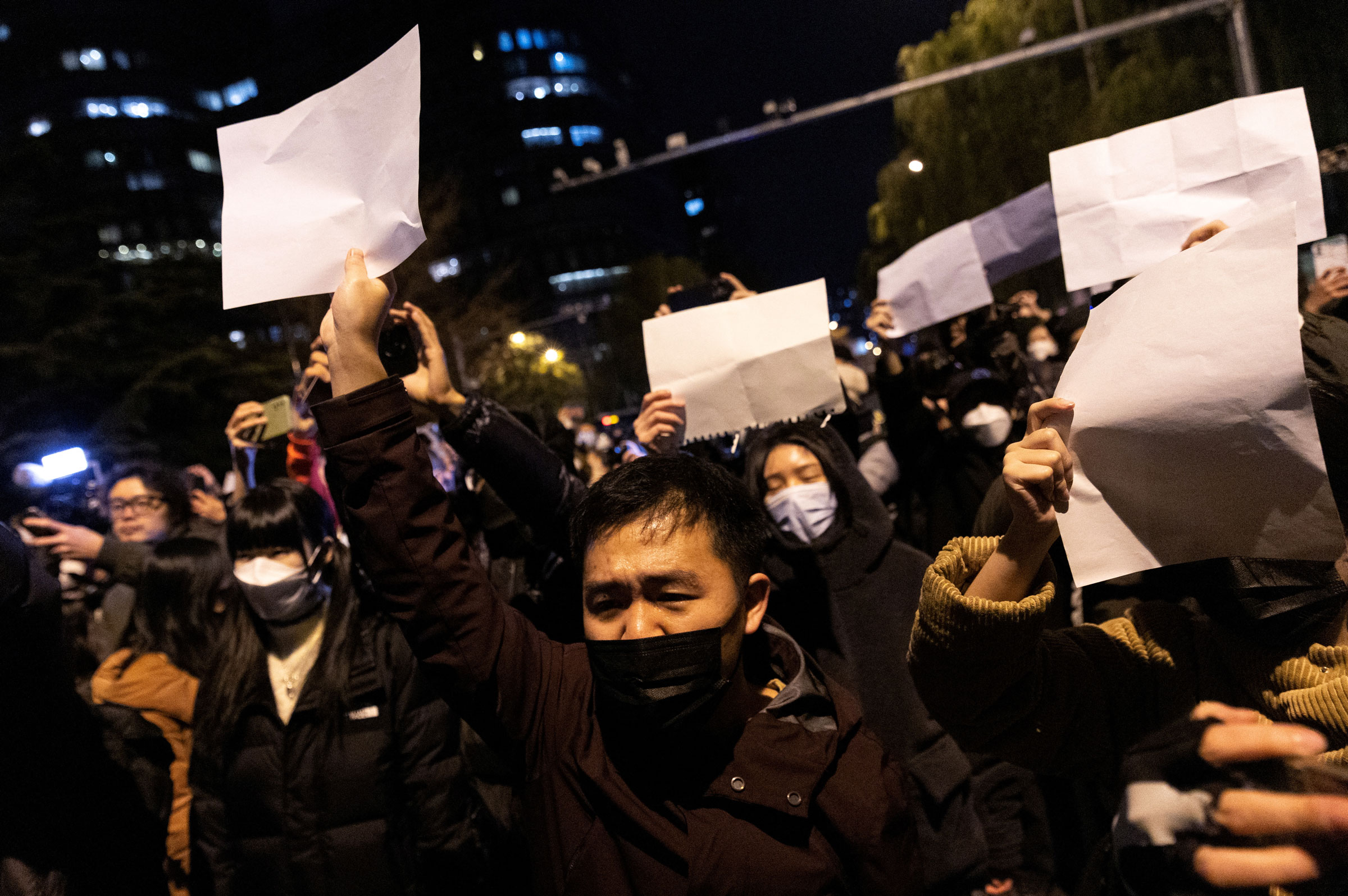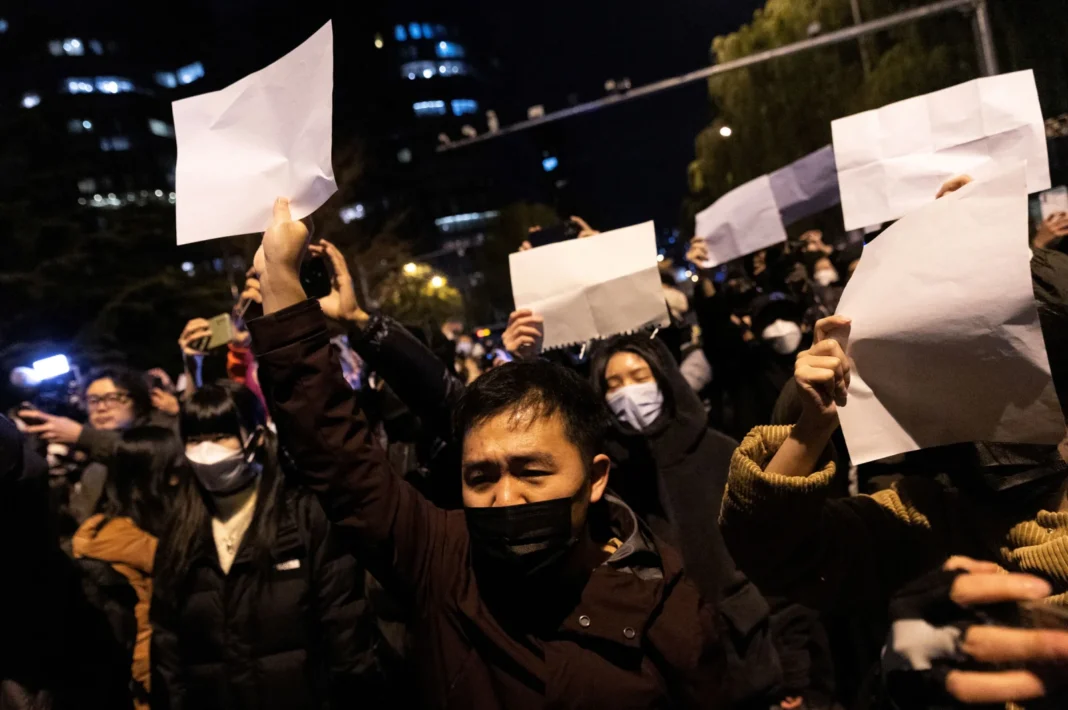s thousands took to the streets across multiple Chinese cities over the last ten days, many have sought to understand the state’s response, any impact this wave of mobilization might have on Chinese politics, and how things might evolve in the coming weeks. It is still very early days and prediction is dangerous, but we can begin to draw some basic lessons.
First, it’s important to recall that Chinese society is intensely contentious. Numerous protests happen every day and have for many years. What made these demonstrations special was that they appeared to have been spurred on by what we might call a master, or umbrella, frame. Sparked by the tragic fire in Urumqi, workers, students, other young people, urbanites upset about delivery of services and public goods, and at least a certain number of broader regime critics all hit upon an anti-lockdown frame that resonated especially strongly. No one seems to have coordinated the protests and there certainly has not been any obvious organization. But what we might call a structural framing process has stood in for any type of entrepreneurial agency we might associate with many social movement, like that in support of Civil Rights in the U.S. during the 1960s.
China’s current contentious coalition is fragile, and already it seems that disparate agendas have started to unravel—likely prefiguring a return to separate spheres of mobilization around labour disputes, campus issues, urban governance, and other concerns that the government finds easier to address and control individually. Indeed, the past several days have not seen high levels of mobilization maintained, not least as claims began to shift toward more general and abstract issues (e.g. censorship and systemic issues in politics) and away from the more concrete and specific grievances that likely animated many at the outset.
Second, the state’s response is critical. When looking at social movements, we often tend to think about state responses in binary form – concede or repress. China’s government hasn’t done either in simple terms. At the very beginning, it seems police stood by and took little meaningful action, perhaps hoping that protests would fizzle of their own accord. Later, they turned the dial toward repression ever so slightly, checking cell phones, asking for identity papers, putting up street barriers, and implementing other ‘nuisance measures’ that seemed to deter many people from protesting. Should more demonstrations break out, or should any movement spiral, there are many options in the CCP’s toolbox short of a sharp or brutal crackdown. Slow-motion, piecemeal, and targeted repression is by far the most likely response.
If the protests peter out, in other words, they will bear greatest resemblance to the ‘Democracy Wall’ movement of 1978-79. If the state manages to choreograph a slow-rolled repressive response successfully, they will look more like what we saw in Hong Kong in 2019-2020. Only if repression on the ground spins out of central leaders’ control, or if protesters refuse to be deterred to the point of provoking a general crisis, will we see anything on the order of Tiananmen in 1989. This last scenario is extremely unlikely.

People hold white sheets of paper in protest over COVID-19 restrictions, after a vigil for the victims of a fire in Urumqi, as outbreaks of COVID-19 continue, in Beijing, China, on Nov. 28, 2022.
Thomas Peter—Reuters
Assuming they do not escalate further, it’s tempting to think the protests haven’t had any significant impact. That would be a mistake. Just this one-off mobilization has shown three things: 1) That an anti-lockdown framing has potential to resonate across a broad range of contentious constituencies; 2) That a non-trivial segment of urban Chinese society is sufficiently aggrieved to turn out in force to support general regime critiques in a manner not seen recently; and 3) That the state has learned valuable lessons about how most effectively to deter or demobilize protesters without resort to costly (in terms of both resources and reputation) and dangerous repression. If this is all that comes of them, the past week’s demonstrations have still taught us to look for more broad-based contention in the future and, perhaps, to set aside our long-held assumptions about the limits of Chinese ‘cellular activism’. They have also shown us that grievances have likely not been assuaged and, if anything, deeper issues have taken root in the hearts of many that could lead them to take bigger risks in challenging the CCP in the future. Finally, we need to adjust our thinking about how authoritarian governments like China’s respond when their citizens mobilize and look for them to deploy much subtler tactics and strategies than we might have realized.
So, where are the protests going? Have they really dissipated? We won’t know that except in hindsight. But we can consider what factors might spur them back to life. Assuming the anti-lockdown frame has run its course, there would need to be a new such construct—or at least a new touchstone similar to the Urumqi fire. It is just possible that former leader Jiang Zemin’s death on November 30 could provide such an event— possible, but not likely. After all, the death of Hu Yaobang on April 15, 1989, was what initially brought students out from campus in displays of mourning that later gradually morphed into a protest movement that culminated in the repression of June 4. Hu had been forced out as CCP General Secretary in 1987 and came to be viewed as a hero among more liberally inclined Chinese citizens. Jiang never enjoyed such a reputation. Indeed, in drawing such a comparison, one is tempted to recall the words of Lloyd Benson to Dan Quayle in deciding that Jiang Zemin is no Hu Yaobang.
That aside, there could well be another moment that gives rise to a widely resonant structural frame. This could come from a new and large outbreak of Covid-19 that the government doesn’t control. It could also come from some less obvious incident or accident that appears related in some way to ongoing lockdowns. It could even come from a wider crisis such as a meltdown in the real estate sector or runaway inflation of food or energy prices. We cannot guess whether any such critical events or moments might occur. Even less can we predict whether they might provide a spark to reignite large-scale protests. But we’ve definitely seen that there is potential for contention encompassing a wide swathe of Chinese society to spring up under current conditions.
Looking further ahead, returning to something closer to what was normal as of the end of 2019 might go some way toward diffusing the underlying grievances that animated the recent protests. But this too is not guaranteed. Chinese society and politics have been in a lengthy cycle of tightening since at least 2007. Loosening—even just in terms of lockdowns and anti-Covid measures—can have unpredictable consequences. Further, Xi Jinping has solidified a degree of political domination and personal control over the apparatus of the state and Party not seen in decades. But he’s also done this in a manner rather different from Mao or even Deng. By emphasizing rules and discipline, he has set up something much more like a rational-bureaucratic authoritarian order than the charismatic and mercurial regime of Mao’s day. This could portend some type of significant initiative is due to follow (for example, with significant new economic reform).
Any major new reform would be fraught, however, as powerful vested interests would need to be either placated or pushed aside. These would include both those who’ve benefitted most under China’s current partial reform equilibrium and many of those least well off, who might stand to lose even more. If Jiang Zemin was wedded to the belief that China needed to strengthen its economy to facilitate greater political power, Xi might well be looking at this through a converse lens, suggesting that political institutions must be strengthened and their control over society cemented before further high-stakes or systemic economic change can occur. Having basically achieved the former, we just might see the latter in the coming years—but not directly because of the recent protests.
time.com

